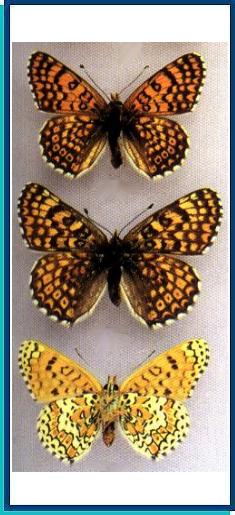LEPIDOPTERA
N Y M P H A L I D A E Swainson, 1827
MELITAEA Fabricius, 1807
Melitaea cinxia (Linnaeus, 1758)
Melitaea cinxia (Linnaeus, 1758)

• TYPE LOCALITY. [Sweden].
• SYNONYMS. pilosella (Rottemburg, 1775); delia ([Denis et Schiffermuller], 1775); abacus (Retzius, 1783). nom. nudum; fulla (Quensel, 1791); amardea Grum-Grshimailo, 1895; Clarissa Staudinger, 1901; horvathi Abafi-Aigner, 1906; kasyi Gross et Ebert, 1975.
• RANGE. The entire Palaearctic except for the polar tundra, N. Siberia and the Far East.
• DISTRIBUTION AND VARIATION. European part, Caucasus and Transcaucasia, Siberia, Sayan, Altais, Transbaikalia, Amur and Ussuri regions, Kopet-Dagh, Tian-Shan, Ghissar, Alai, Tarbagatai and Saur mts. From the territories concerned, several subtaxa have been described: heynei Ruhl, 1893 (TL: Alai); tschujaca Seitz, [1909] (TL: Altai); sacarina Fruhstorfer, 1917 (TL: Saratov); karavqjeui Obraztsov, 1936 (TL: Zhurovka, Kherson Region, Ukraine). However, as the distinctions between the populations within the entire distribution area are very small, division into subspecies seems unwarranted. Yet the specimens from the southern populations tend to be larger and lighter than the northern ones.
• HABITATS AND BIOLOGY. A species rather common everywhere, flying over dry meadows, in the mountains up to 2,500 m a.s.l. Flight period: from May to September. Up to 3-4 generations in the south. Host plants: Plantago, Veronica, Viola, Centaurea, Hieracium, etc. Instar 1 larvae living together in a colony inside a cobweb nest. Hibernation larval.
• SIMILAR SPECIES. Melitaea punica, M. turcmanica: submarginal fascia of UPH without black spots.
Photo and text: Guide to the BUTTERFLIES OF RUSSIA and adjacent territories Volume 2. PENSOFT, Sofia - Moscow. 2000